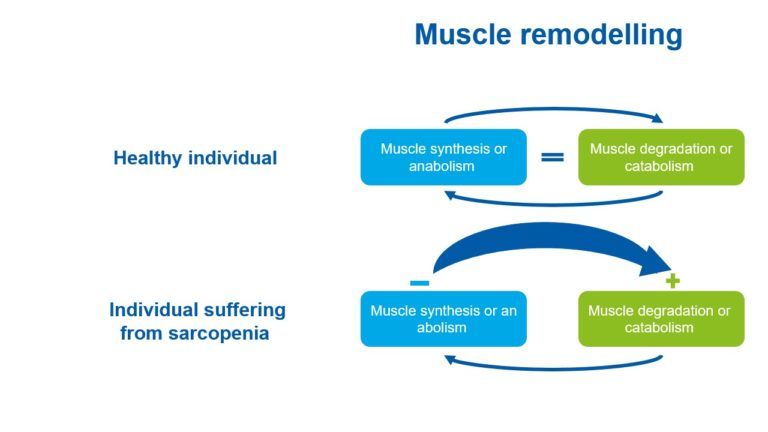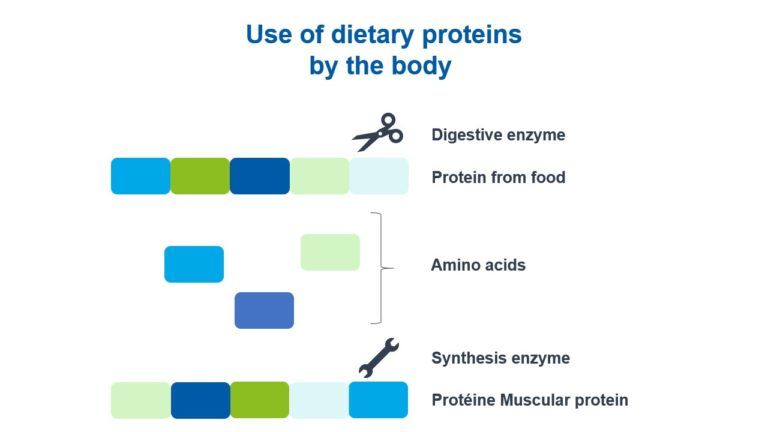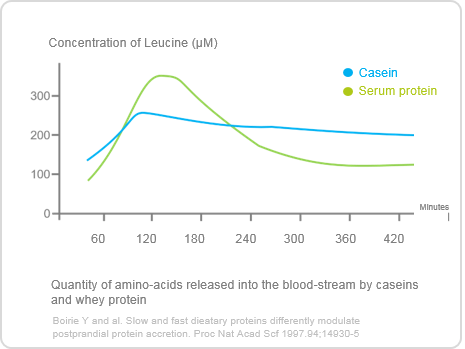Sarcopenia: a major public health issue among the elderly, linked to changing nutritional needs
Prevalence of sarcopenia
Worldwide, 5 to 25% of people between 60 and 70 years of age are affected by sarcopenia. This proportion reaches 30 to 50% for people aged over 80 years old (*2).
What is sarcopenia?
The loss of muscle mass is a natural phenomenon that occurs from the age of 30. This averages 1% per year. However, this process speeds up from the age of 50. It is then accompanied by a significant decrease in strength and physical performance, which are the main symptoms of sarcopenia (*2).
Sarcopenia can be diagnosed using performance measurements such as clinical tests of strength, walking speed, or even knee flexion. It is also possible to detect it with muscle mass measurements (*2).
The main cause of this disorder lies in the imbalance between the processes of synthesis (anabolism) and degradation (catabolism) of muscle proteins. In effect, synthesis is no longer sufficient to counterbalance degradation, leading to muscle wasting. Numerous factors can encourage the emergence of this imbalance:
- A change in the nervous control of muscle contraction,
- A decrease in the level of anabolic hormones, a low level of muscle use
- Or even an inadequate nutritional intake of proteins (*2).

Proteins: basic nutritional intake for good muscle health
Proteins are made up of small units called amino acids. When we consume proteins, the body segments them into amino acids. They are then used to form proteins again, which will build muscle.

It is thus crucial that food provide the necessary amount of protein to ensure optimal muscle synthesis. However, the metabolism for producing proteins becomes less efficient with age. The amount of proteins provided by food must thus be increased.
A team of researchers (*3) recently carried out a situational analysis on scientific data regarding optimal protein intake. For young adults, it is 0.8 g of proteins per kilogram of body weight per day. From 55 years of age, a person in good health should consume a greater quantity, between 1 and 1.2 g of proteins per kilogram of body weight per day. This means that for a person weighing 70 kg, protein intake should be between 70 and 84 g per day. However, 30% of people over 60 years old consume less than what they need.
For elderly people, it is also recommended that this protein intake be provided in the same quantity every day and in as few doses as possible. This is because metabolism is slower and one large intake allows the body to optimise absorption (*3).
The nature of the proteins ingested also plays a crucial role in muscle synthesis. It has been shown that proteins made of branched-chain amino acids (BCAAs) – leucine, valine and isoleucine – are better digested by the body. These amino acids are better assimilated and are associated with an increase in muscle mass. Proteins rich in branched-chain amino acids are mainly of animal origin. They are particularly present in dairy products. Leucine is the branched-chain amino acid best known to stimulate muscle synthesis. It is found in significant quantities in serum proteins, particularly in native proteins (*3). An adapted intake of serum proteins can thus help to prevent sarcopenia.

On the other hand, numerous studies (*3) highlight that serum protein supplements, combined with resistance exercises such as walking or the gym, lead to a greater increase in muscle mass in people aged 70 to 85 years old, thus limiting the development of sarcopenia.
Consequences of sarcopenia

Sarcopenia leads to a decrease in physical performance, the main consequence of which is a loss of autonomy in the elderly population.
This can result in gait disorders, for example, which are notably responsible for an increased risk of falling. Sarcopenia increases bone fragility and fractures, which can lead to immobilisation and even hospitalisations. These instances of immobilisation then stop the muscles from being used, which further accentuates their atrophy and makes people suffering from sarcopenia more fragile (*4).
How can sarcopenia be prevented?
Sarcopenia can be prevented on two levels, by:
- Increasing protein intake from the age of 50 in order to meet the recommendations and encourage good muscle synthesis. Choosing proteins rich in branched-chain amino acids, particularly leucine, which will encourage anabolism.
- Increasing physical activity, which will stimulate muscle synthesis.
Why choose Eurial I&N solutions to formulate your nutritional products intended to prevent sarcopenia in the elderly?
Eurial I&N offers nutritional solutions adapted to the protein needs of elderly populations. Our dairy ingredients provide a natural and high quality intake of branched-chain amino acids, preventing sarcopenia. Our non-denaturing manufacturing processes help to preserve the functional and technological properties of our proteins while ensuring a neutral taste. Find out more:
- EuriNutri™ 80 WPC : a concentrated serum protein with high microbiological quality.
- EuriNutri™ 90 WPI : a 90% whey protein isolate with an excellent amino acid profile.
- EuriNutri™ 80 NS : a native protein derived directly from milk with an excellent amino acid profile.
- Eurimilk 60.1 : milk proteins allowing for protein enrichment and a gourmet product texture.
Eurial I&N is a partner for formulating products intended for nutrition for the elderly, particularly as part of preventing sarcopenia. Thanks to our R&D team dedicated to creating concepts for the agrifood industry, we offer numerous applications of ingredients adapted to all your needs. Contact us to learn more about nutrition for the elderly and existing solutions.
References :
(1) https://www.ch-carcassonne.fr/imgfr/files/vieillissementphysiologique.pdf
(2) https://www.chu-bordeaux.fr/Les-services/Service-de-m%C3%A9decine-physique-et-de-r%C3%A9adaptation/PATHOLOGIES/Sarcop%C3%A9nie/
(3) Deer RR, Volpi E. Protein intake and muscle function in older adults. Curr Opin Clin Nutr Metab Care. 2015 May;18(3):248-53. doi: 10.1097/MCO.0000000000000162. PMID: 25807346; PMCID: PMC4394186.
(4) Sobestiansky, S., Michaelsson, K. & Cederholm, T. Sarcopenia prevalence and associations with mortality and hospitalisation by various sarcopenia definitions in 85–89 -year-old community-dwelling men: a report from the ULSAM study. BMC Geriatr 19, 318 (2019). https://doi.org/10.1186/s12877-019-1338-1


